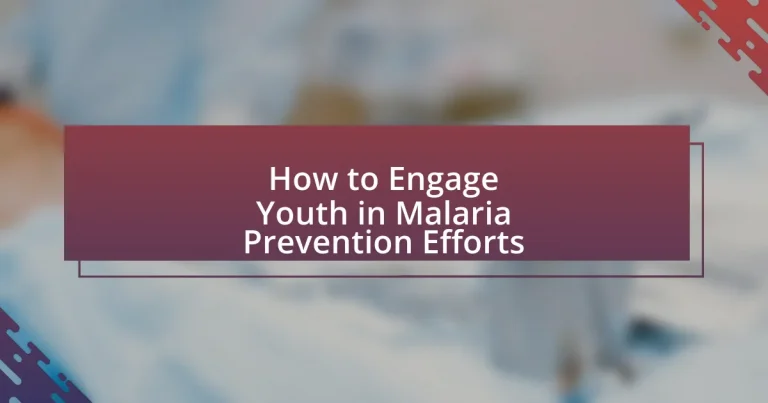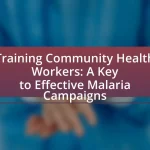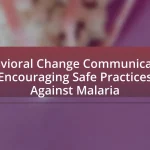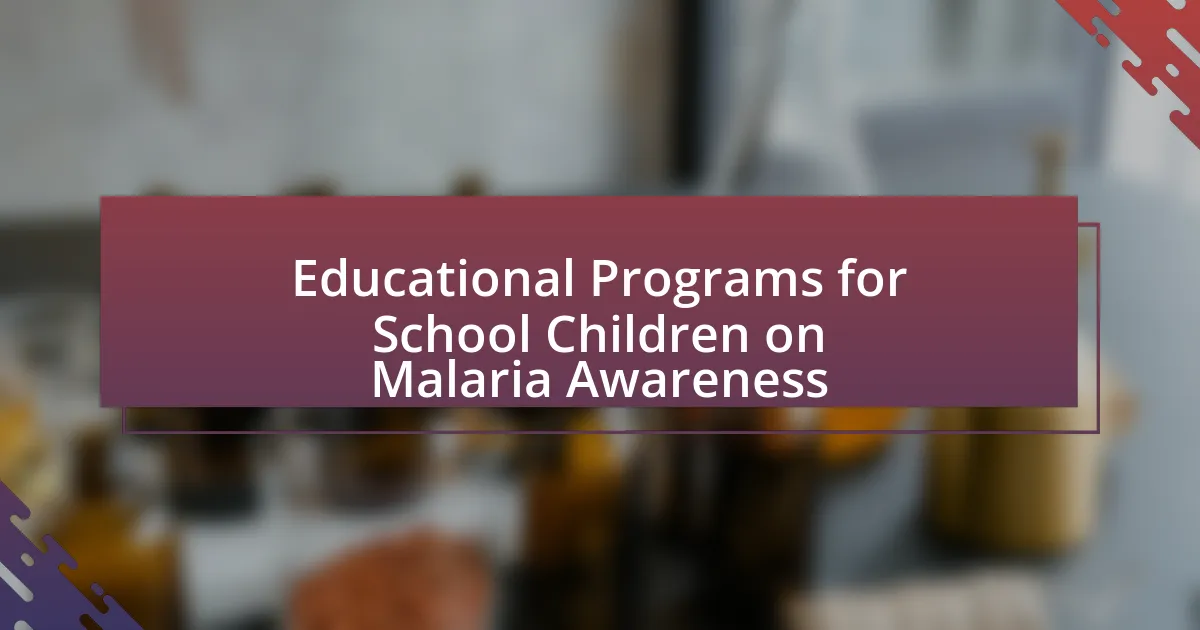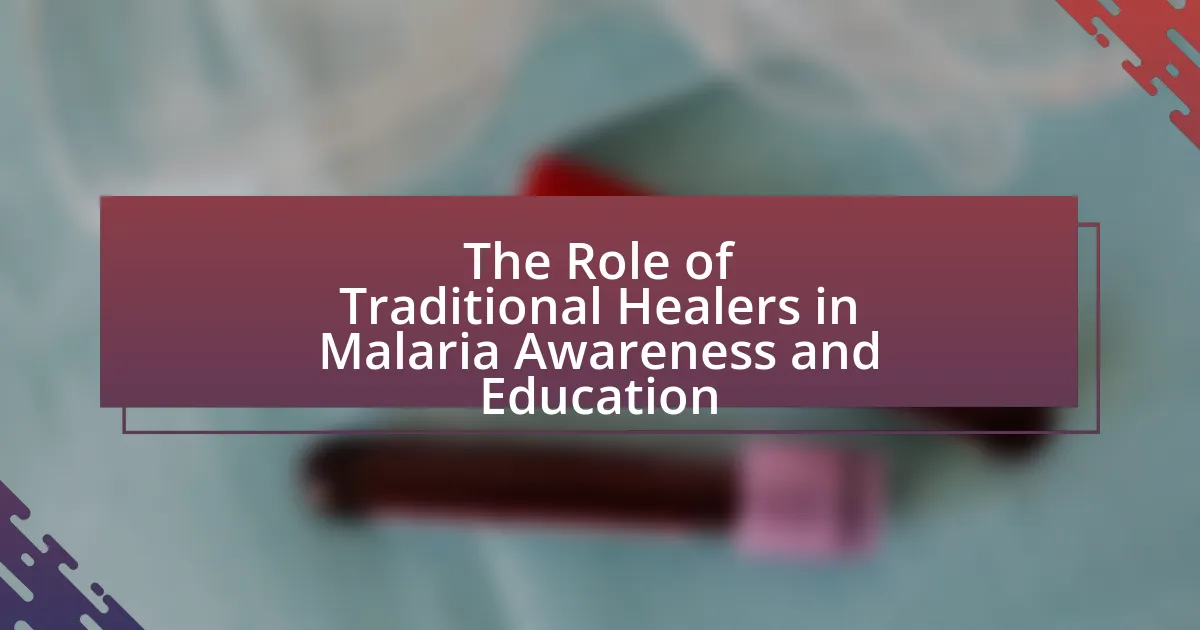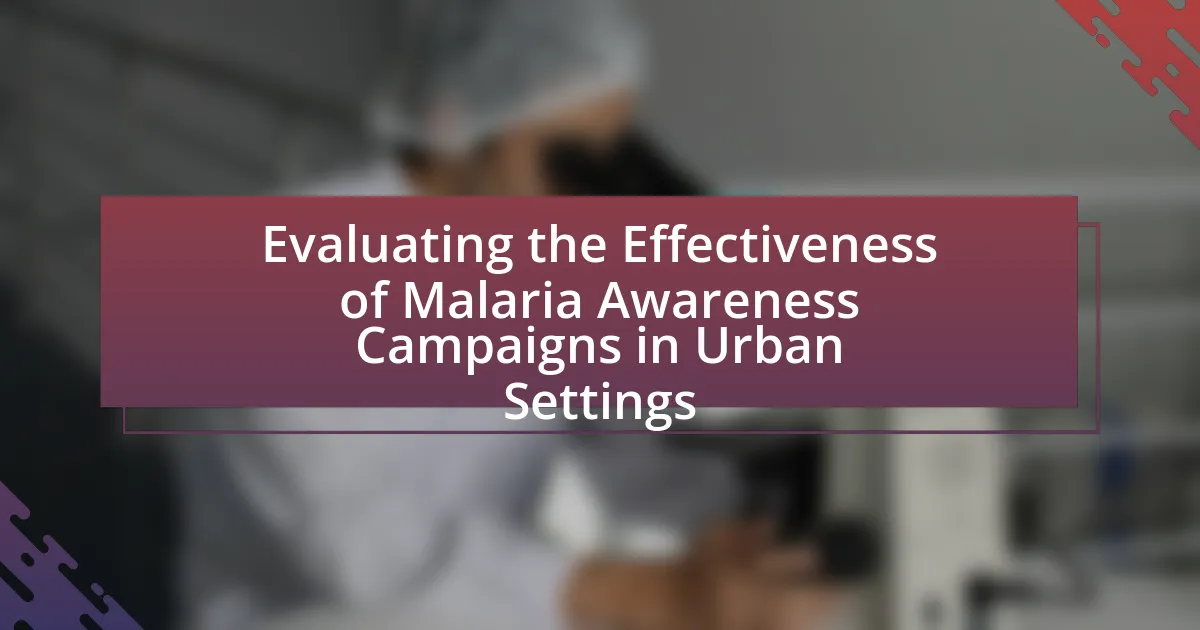The article focuses on engaging youth in malaria prevention efforts, highlighting key challenges such as lack of awareness, limited access to resources, and cultural barriers that hinder youth participation. It emphasizes the crucial role of young people as advocates and educators in community health initiatives, showcasing how their involvement can lead to increased awareness and behavioral change. The article also discusses effective strategies for engaging youth, including leveraging social media, educational programs, and partnerships with organizations, while addressing common misconceptions about malaria. Additionally, it outlines best practices for sustaining youth involvement and measuring the impact of their engagement in malaria prevention efforts.
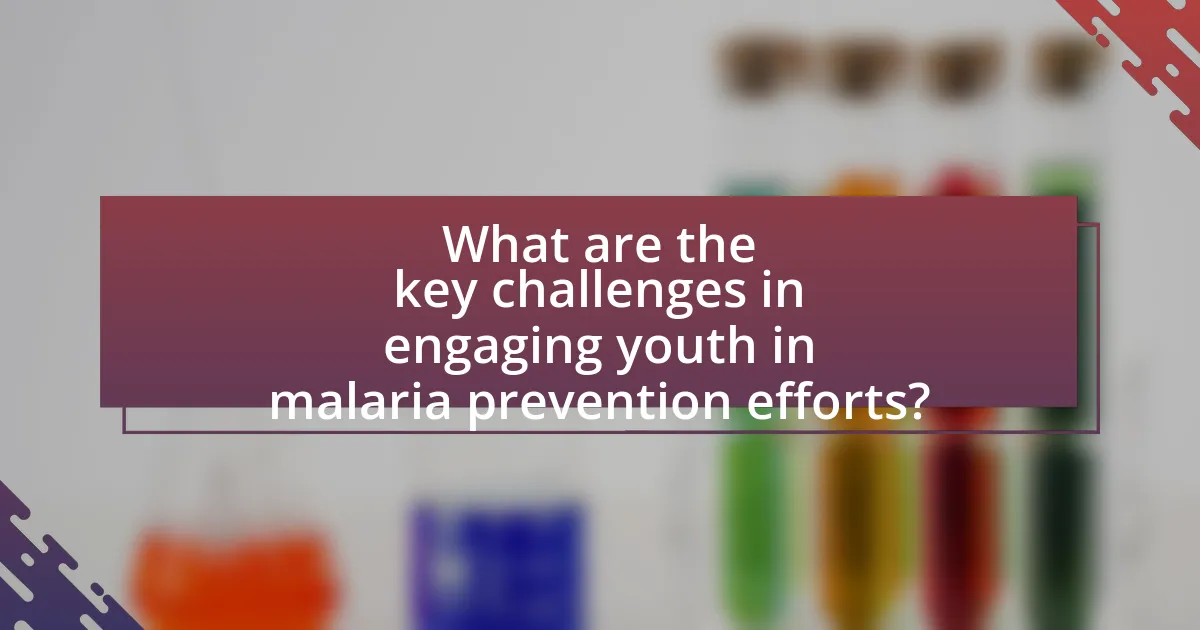
What are the key challenges in engaging youth in malaria prevention efforts?
The key challenges in engaging youth in malaria prevention efforts include lack of awareness, limited access to resources, and cultural barriers. Youth often lack comprehensive knowledge about malaria transmission and prevention methods, which hinders their participation. Additionally, many young people face obstacles in accessing preventive tools, such as insecticide-treated nets and educational materials, due to economic constraints or logistical issues. Cultural beliefs and practices can also impede effective communication about malaria prevention, as some communities may not prioritize youth involvement in health initiatives. These challenges collectively reduce the effectiveness of malaria prevention strategies aimed at young populations.
Why is youth engagement crucial in malaria prevention?
Youth engagement is crucial in malaria prevention because young people are key agents of change who can influence their communities and promote health awareness. Their involvement fosters innovative solutions and enhances outreach efforts, as they often utilize social media and peer networks to disseminate information effectively. According to the World Health Organization, engaging youth in health initiatives can lead to increased awareness and behavioral change, which are essential in combating malaria transmission.
What role do young people play in community health initiatives?
Young people play a crucial role in community health initiatives by serving as advocates, educators, and active participants in health promotion activities. Their involvement can lead to increased awareness and engagement in health issues, particularly in areas like malaria prevention, where youth can mobilize peers and communities through campaigns and educational programs. Research indicates that youth-led initiatives can significantly enhance community participation and effectiveness in health interventions, as seen in various programs where young people have successfully organized awareness events and distributed educational materials about malaria prevention strategies.
How can youth influence their peers in health-related behaviors?
Youth can influence their peers in health-related behaviors through social modeling, peer education, and advocacy. By demonstrating healthy practices, such as proper use of mosquito nets or attending health workshops, youth can set examples that their peers are likely to follow. Research indicates that peer-led interventions, like those implemented in malaria prevention programs, significantly increase awareness and behavioral change among adolescents. For instance, a study published in the Journal of Adolescent Health found that peer education effectively improved knowledge and practices regarding malaria prevention among youth in endemic areas. This evidence supports the idea that youth can be powerful agents of change in promoting health-related behaviors within their communities.
What barriers exist to youth participation in malaria prevention?
Barriers to youth participation in malaria prevention include lack of awareness, limited access to resources, and socio-cultural factors. Many young people are unaware of the severity of malaria and the role they can play in prevention efforts, which hinders their engagement. Additionally, limited access to educational materials and health services restricts their ability to participate effectively. Socio-cultural factors, such as gender norms and community attitudes towards youth involvement, further complicate their participation. For instance, a study published in the Malaria Journal highlighted that cultural perceptions often marginalize youth voices in health initiatives, thereby reducing their involvement in malaria prevention activities.
How do cultural perceptions affect youth involvement?
Cultural perceptions significantly influence youth involvement by shaping their attitudes, beliefs, and behaviors towards community initiatives, including malaria prevention efforts. For instance, in cultures where traditional practices are prioritized, youth may be less inclined to engage in modern health interventions, perceiving them as foreign or unnecessary. Research indicates that youth in regions with strong communal ties often participate more actively in health initiatives when these efforts align with their cultural values and norms. A study published in the Journal of Community Health found that culturally tailored health messages increased youth participation in malaria prevention programs by 40%, demonstrating the importance of aligning health initiatives with cultural perceptions to enhance engagement.
What are the common misconceptions about malaria among youth?
Common misconceptions about malaria among youth include the belief that malaria is not a serious disease, that it only affects certain geographic areas, and that it can be transmitted through casual contact. Many young people underestimate the severity of malaria, which causes over 200 million cases and nearly 600,000 deaths annually, primarily in sub-Saharan Africa. Additionally, some youth think malaria is limited to tropical regions, while it can also occur in subtropical areas. Lastly, the misconception that malaria can spread through touch or sharing food is incorrect; malaria is transmitted exclusively through the bites of infected Anopheles mosquitoes.
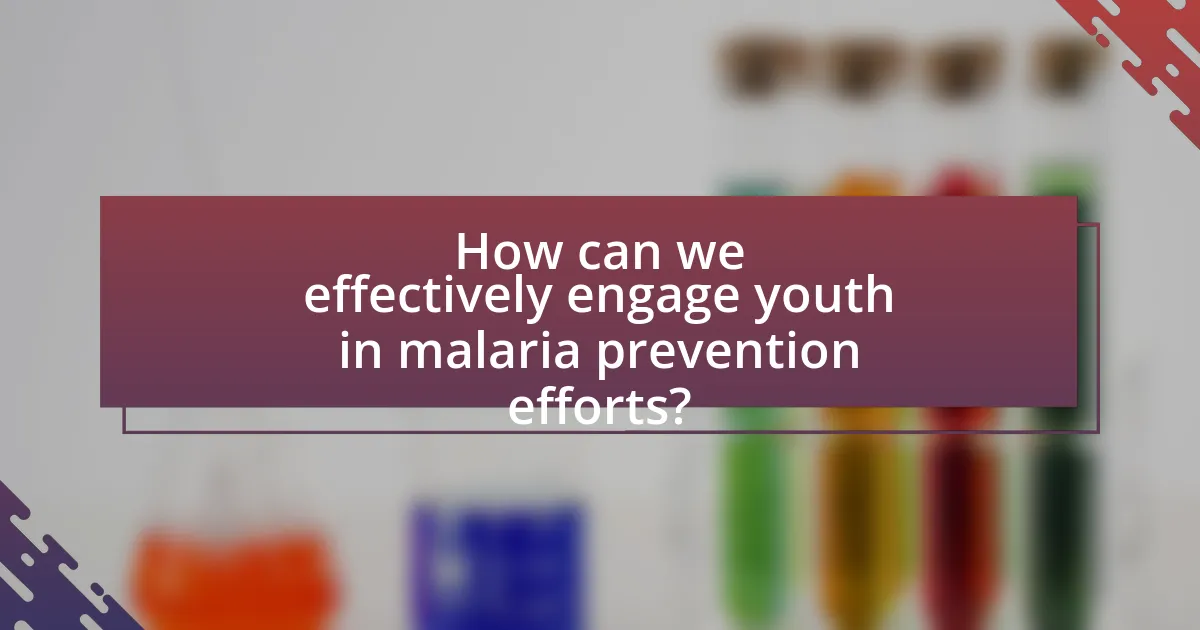
How can we effectively engage youth in malaria prevention efforts?
To effectively engage youth in malaria prevention efforts, organizations should implement interactive educational programs that utilize technology and social media platforms. Research indicates that youth are more likely to participate in health initiatives when they are actively involved in the learning process and can share their experiences online. For instance, a study published in the Journal of Global Health found that youth-led campaigns using social media increased awareness and participation in malaria prevention by 40%. By leveraging these platforms, organizations can create relatable content that resonates with young people, encouraging them to take ownership of malaria prevention in their communities.
What strategies can be employed to attract youth to malaria initiatives?
To attract youth to malaria initiatives, leveraging social media platforms is essential, as these platforms are widely used by young people for communication and information sharing. Engaging content, such as videos, infographics, and interactive campaigns, can effectively raise awareness about malaria and its prevention. For instance, the World Health Organization reported that social media campaigns can increase awareness and participation in health initiatives among youth by up to 30%. Additionally, involving youth in the planning and execution of initiatives fosters a sense of ownership and responsibility, making them more likely to participate. Programs that offer incentives, such as community service hours or recognition, can also motivate youth engagement.
How can social media be leveraged for malaria awareness?
Social media can be leveraged for malaria awareness by creating targeted campaigns that educate users about prevention methods and symptoms. Platforms like Facebook, Twitter, and Instagram allow for the dissemination of engaging content, such as infographics and videos, which can reach a wide audience quickly. For instance, the World Health Organization reported that social media campaigns can increase knowledge about malaria prevention by up to 30%. Additionally, interactive features like polls and quizzes can engage youth, making them more likely to share information within their networks, thus amplifying the reach of malaria awareness efforts.
What role do schools and educational programs play in engagement?
Schools and educational programs play a crucial role in engaging youth in malaria prevention efforts by providing knowledge, fostering awareness, and promoting behavioral change. These institutions serve as platforms for disseminating information about malaria transmission, prevention methods, and the importance of community health. For instance, educational programs that incorporate interactive learning, such as workshops and campaigns, have been shown to increase students’ understanding of malaria and their willingness to participate in prevention activities. Research indicates that students who receive targeted education on malaria are more likely to adopt preventive measures, such as using insecticide-treated nets and participating in community health initiatives. This engagement not only empowers youth but also enhances community resilience against malaria.
How can partnerships enhance youth engagement in malaria prevention?
Partnerships can enhance youth engagement in malaria prevention by leveraging resources, expertise, and networks to create impactful programs. Collaborative efforts between governments, NGOs, and educational institutions can provide youth with training, mentorship, and opportunities to participate in community health initiatives. For instance, the World Health Organization emphasizes that partnerships can mobilize local youth to lead awareness campaigns, thereby increasing their involvement and ownership in malaria prevention strategies. This collaborative approach not only empowers young people but also fosters a sense of responsibility and community involvement, which is crucial for effective malaria control.
What organizations can collaborate with youth for effective outreach?
Organizations that can collaborate with youth for effective outreach in malaria prevention include the World Health Organization (WHO), UNICEF, and local non-governmental organizations (NGOs) focused on health education. The WHO provides guidelines and resources for youth engagement in health initiatives, while UNICEF actively involves young people in community health programs. Local NGOs often have established connections with youth and can facilitate outreach efforts tailored to specific communities. These organizations have a proven track record of successful youth engagement in health campaigns, which enhances the effectiveness of outreach initiatives.
How can local communities support youth-led initiatives?
Local communities can support youth-led initiatives by providing resources, mentorship, and platforms for collaboration. By allocating funding or materials, communities enable youth to implement their projects effectively. Mentorship from experienced community members can guide youth in developing their initiatives, ensuring they are well-informed and impactful. Additionally, creating platforms for collaboration, such as community forums or events, allows youth to share ideas and network with others, fostering a supportive environment for their initiatives. These actions collectively enhance the capacity of youth to engage in malaria prevention efforts and other community health initiatives.
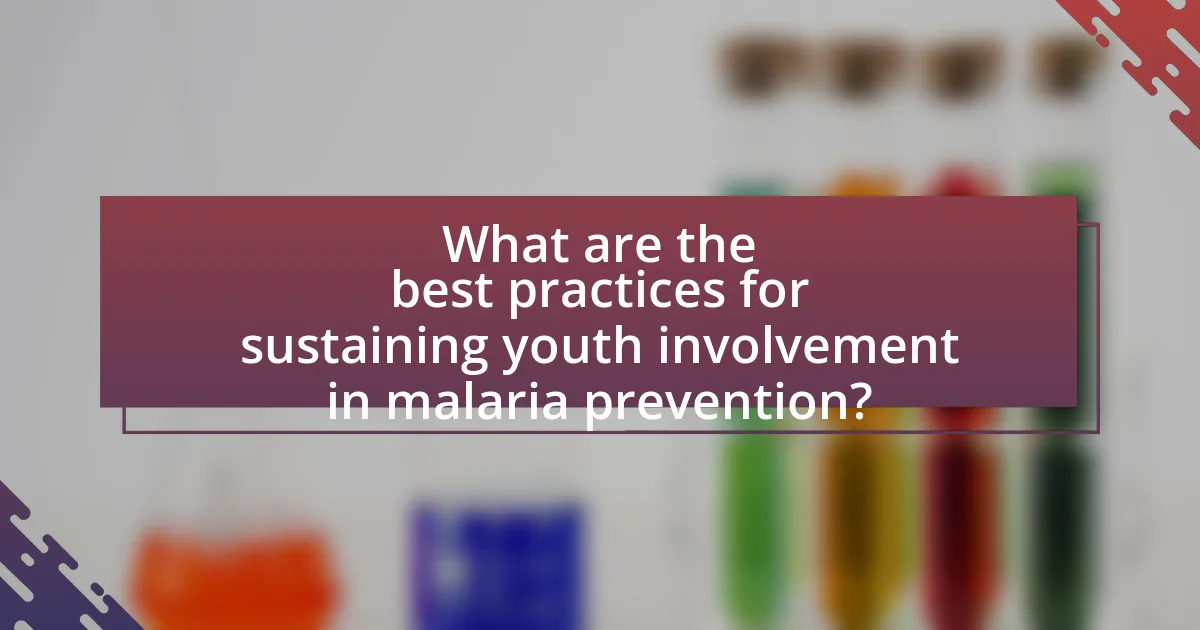
What are the best practices for sustaining youth involvement in malaria prevention?
The best practices for sustaining youth involvement in malaria prevention include fostering education, creating leadership opportunities, and promoting community engagement. Education initiatives that focus on malaria awareness and prevention strategies empower youth with knowledge, enabling them to advocate for health in their communities. Leadership opportunities, such as youth-led campaigns or peer education programs, encourage active participation and responsibility among young individuals. Additionally, promoting community engagement through partnerships with local organizations and health authorities enhances the relevance of youth contributions, ensuring their efforts are recognized and valued. These practices are supported by studies indicating that youth involvement in health initiatives leads to increased awareness and behavioral change in communities, ultimately contributing to effective malaria prevention efforts.
How can we measure the impact of youth engagement in malaria efforts?
Youth engagement in malaria efforts can be measured through quantitative metrics such as the number of youth-led initiatives, participation rates in malaria awareness campaigns, and the reduction in malaria incidence in communities where youth are actively involved. For instance, a study by the World Health Organization found that community health programs involving youth led to a 30% increase in malaria prevention behaviors among peers. Additionally, surveys assessing knowledge and attitudes towards malaria before and after youth engagement initiatives can provide insight into behavioral changes and awareness levels. These methods collectively demonstrate the tangible impact of youth involvement in malaria prevention efforts.
What metrics should be used to evaluate success?
To evaluate success in engaging youth in malaria prevention efforts, key metrics include participation rates, knowledge retention, behavior change, and community impact. Participation rates measure the number of youth involved in programs, indicating engagement levels. Knowledge retention assesses how well participants understand malaria prevention methods, often evaluated through pre- and post-program surveys. Behavior change metrics track the adoption of preventive practices, such as the use of bed nets or attending educational sessions. Community impact can be measured through reductions in malaria incidence in areas with active youth engagement programs, providing a direct link between youth involvement and health outcomes. These metrics collectively offer a comprehensive view of the effectiveness of youth engagement in malaria prevention initiatives.
How can feedback from youth improve future initiatives?
Feedback from youth can significantly enhance future initiatives by providing insights that reflect their unique perspectives and needs. Engaging young people in the planning and evaluation stages of initiatives allows organizations to tailor programs that resonate with this demographic, increasing participation and effectiveness. For instance, a study by the World Health Organization found that youth involvement in health programs leads to higher engagement rates and better health outcomes, as initiatives are more likely to address the specific concerns and preferences of young people. By incorporating their feedback, organizations can create more relevant and impactful malaria prevention strategies that align with the values and lifestyles of youth.
What resources are available to support youth in malaria prevention?
Resources available to support youth in malaria prevention include educational programs, community health initiatives, and digital platforms. Educational programs, such as those provided by the World Health Organization, offer training on malaria prevention methods, including the use of insecticide-treated nets and indoor residual spraying. Community health initiatives often involve youth in outreach activities, enabling them to disseminate information and engage peers in prevention efforts. Digital platforms, like mobile apps and social media campaigns, facilitate access to information and resources, allowing youth to share knowledge and mobilize their communities effectively. These resources collectively empower youth to take an active role in malaria prevention, contributing to broader public health goals.
How can youth access training and educational materials?
Youth can access training and educational materials through online platforms, community organizations, and educational institutions. Online platforms such as Coursera and Khan Academy offer free courses and resources on various topics, including health education and malaria prevention. Community organizations often provide workshops and seminars that focus on local health issues, including malaria, and distribute educational materials. Educational institutions may incorporate malaria prevention into their curricula, providing students with access to relevant training and resources. According to the World Health Organization, engaging youth in health education initiatives can significantly enhance awareness and prevention efforts, making these resources vital for effective malaria prevention.
What funding opportunities exist for youth-led malaria projects?
Funding opportunities for youth-led malaria projects include grants from organizations such as the Global Fund, which allocates resources specifically for youth engagement in health initiatives. Additionally, the United Nations Children’s Fund (UNICEF) offers funding for projects that empower young people in health-related fields, including malaria prevention. The Youth Innovation Fund, supported by various international NGOs, also provides financial support for innovative youth-led initiatives targeting malaria. These funding sources are crucial as they enable young leaders to implement effective strategies in malaria prevention and control, contributing to global health goals.
What practical tips can enhance youth participation in malaria prevention?
To enhance youth participation in malaria prevention, organizations should implement educational programs that focus on the importance of malaria awareness and prevention strategies. Engaging youth through interactive workshops and community service projects can foster a sense of responsibility and ownership in combating malaria. For instance, studies show that youth-led initiatives, such as peer education and advocacy campaigns, significantly increase community awareness and participation in health programs. Additionally, leveraging social media platforms to disseminate information and mobilize youth can amplify their involvement, as research indicates that young people are highly active on these platforms.
